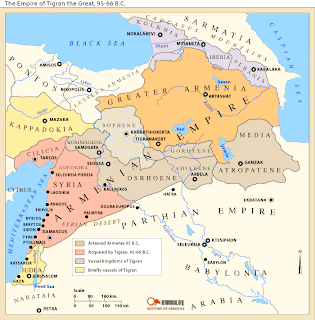Artashes II (also called Artaxes or Artashes, Armenian: Արտաշես Երկրորդ) (reigned 34 BC – 20 BC) was a king of Armenia, the eldest son of Artavasdes II. He ascended the throne when his father was taken prisoner and executed by Marcus Antonius, and after his own skirmish with the Romans was forced to flee to Parthia. With the support of the Parthians, however, he returned to Armenia and successfully made war on Artavasdes I of Media Atropatene, an enemy of his father. He also executed all the Romans who could be found within his borders. Possibly as a consequence of this action, when Artaxias sent emissaries to Rome to try and secure the release of his relatives then in Roman captivity, Caesar Augustus refused him.
In 20 BCE, the Armenians sent messengers to Augustus to tell him that they no longer wanted Artaxias as their king, and asked that his brother Tigranes (then in Roman custody) be installed in his place. Augustus readily agreed, and sent a large army under Tiberius to depose Artaxias. Before they arrived, however, Artaxias was assassinated by some of his other relatives, and the Romans put Tigranes on the throne unopposed.
blog Artashes Avetisyan
KING ARTASHES
Blog About King Artashes And Armenian history
Wednesday, November 17, 2010
Tuesday, October 26, 2010
Monday, October 25, 2010
KING ARTASHES
Artaxias I (also called Artaxes or Artashes, Armenian: Արտաշես Առաջին Բարեպաշտ) (reigned 190 BC/189 BC–160 BC/159 BC) was the founder of the Artaxiad Dynasty whose members ruled the Kingdom of Armenia for nearly two centuries.
By the end of the 3rd century BC, the kingdom of Armenia was made up of around 120 dynastic domains ruled by nakharars, loosely united under the Orontid kings of Greater and Lesser Armenia.[1] Even though Alexander the Great did not conquer Armenia, Hellenistic culture had strongly impacted Armenian society. When Antiochus the Great wrestled Armenia from Orontid rule, he appointed Artaxias as strategos.
Following his monarch's defeat by the Romans at the Battle of Magnesia in 190 BC, Artaxias and his co-strategos Zariadres revolted and, with Roman consent, began to reign autonomously with the title of king; Artaxias over Greater Armenia and Zariadres over Sophene/Lesser Armenia[2].
From the time of the state of Hayasas, until that of Artaxias I, more than one thousand years elapsed, and during that period the Hayasas, the Armens, the people of Nairi and other ethnic elements were integrated, became one nation, spoke the same language, and lived together in a country that became known as Armenia[3].
Artaxias was married to Satenik, daughter of the king of Alans. They had six sons: Artavasdes (Artavazd), Vruyr, Mazhan, Zariadres (Zareh), Tiran and Tigranes (Tigran). Artaxias founded a capital, Artaxata on the Araks River near Lake Sevan. Hannibal took refuge there at his court when Antiochus could not protect him any longer. Artaxias was taken captive by Antiochus IV Epiphanes when he attacked Armenia around 165 BC.
blog Artashes Avetisyan
By the end of the 3rd century BC, the kingdom of Armenia was made up of around 120 dynastic domains ruled by nakharars, loosely united under the Orontid kings of Greater and Lesser Armenia.[1] Even though Alexander the Great did not conquer Armenia, Hellenistic culture had strongly impacted Armenian society. When Antiochus the Great wrestled Armenia from Orontid rule, he appointed Artaxias as strategos.
Following his monarch's defeat by the Romans at the Battle of Magnesia in 190 BC, Artaxias and his co-strategos Zariadres revolted and, with Roman consent, began to reign autonomously with the title of king; Artaxias over Greater Armenia and Zariadres over Sophene/Lesser Armenia[2].
From the time of the state of Hayasas, until that of Artaxias I, more than one thousand years elapsed, and during that period the Hayasas, the Armens, the people of Nairi and other ethnic elements were integrated, became one nation, spoke the same language, and lived together in a country that became known as Armenia[3].
Artaxias was married to Satenik, daughter of the king of Alans. They had six sons: Artavasdes (Artavazd), Vruyr, Mazhan, Zariadres (Zareh), Tiran and Tigranes (Tigran). Artaxias founded a capital, Artaxata on the Araks River near Lake Sevan. Hannibal took refuge there at his court when Antiochus could not protect him any longer. Artaxias was taken captive by Antiochus IV Epiphanes when he attacked Armenia around 165 BC.
blog Artashes Avetisyan
KING ARTASHES
KING ARTASHES
- Artaxias also spelled ARTASHES (fl. 2nd century BC) one of the founders of the ancient kingdom of Armenia (reigned 190-159 BC). After the defeat of the Seleucid king Antiochus III the Great by the Romans in the Battle of Magnesia (190), Artaxias and Zariadres, who were Antiochus' satraps (governors) in Armenia, revolted and established themselves with Roman consent as kings of Greater Armenia and its district of Sophene to the southwest, respectively. They united their efforts to enlarge their domains at the expense of neighbouring areas and are considered the creators of historical Armenia. Artaxias built his capital, Artaxata, on the Araxes (now Aras, or Araks) River near Lake Sevan.
Subscribe to:
Posts (Atom)




